Fantasy Books
On McPig's Wishlist - The Warbler
 The Warblerby Sarah Beth Durst
The Warblerby Sarah Beth DurstFrom the author of The Lies Among Us comes a magical tale about mothers and daughters, choices and consequences, and the real meaning of home when every place feels like a cage.
Ten months. That’s the longest Elisa has stayed anyplace, constantly propelled by her fear that if she puts down roots, a family curse will turn her into a tree.
But she’s grown tired of flitting from town to town and in and out of relationships. When she discovers a small town in Massachusetts where mysterious forces make it impossible for the residents to leave, she hopes she can change her fate.
As Elisa learns about the town’s history, she understands more about the women in her family, who seem doomed to never get what they want. Now she believes she’s stuck, too—is that a patch of bark on her arm? But her neighbor’s collection of pet birds sings secrets that Elisa can almost understand—secrets she must unravel in order to be truly alive.
Book Review: White Line Fever by K.C. Jones
I received a review copy from the publisher. This does not affect the contents of my review and all opinions are my own.
 White Line Fever by K.C. Jones
White Line Fever by K.C. Jones
Mogsy’s Rating: 3.5 of 5 stars
Genre: Horror
Series: Stand Alone
Publisher: Nightfire (March 18, 2025)
Length: 368 pages
Author Information: Website
When it comes to horror stories, a girls’ weekend road trip meets a haunted highway sounds like it would be a match made in heaven. This is essentially the premise of K.C. Jones’ White Line Fever, which made me very excited to read it. But while the book is brimming with terrifying potential and starts off on the right track, it struggles to maintain that momentum, and by the end, I found myself more frustrated than thrilled.
The book follows Livia and her lifelong friends Ash, Mo, and Becka, who have affectionately called themselves “The Scoundrels” ever since their childhood days of adventure and mischief. As the story begins, Livia is passing another normal day doing laundry when she makes a devastating discovery while emptying her husband’s pants pockets—an unfamiliar condom wrapper, torn open. The shocking revelation of his infidelity immediately plunges Livia into a dark place. After growing up in an abusive home and eventually escaping her cruel and violent father, she’d thought she finally found happiness. Alas, it was not to be. Needing to get away, Livia turns to her old trio of friends, who suggest taking a road trip into the Oregon wilderness where they can all benefit from some quiet time away from life’s ugly realities.
However, their trip takes a dark turn when an unsettling encounter with an aggressive driver in a pickup truck forces them to take a shortcut through the backroads, onto County Road 951—known to locals as The Devil’s Driveway. Short as it may be, countless tragedies have occurred on this road, spawning dozens of urban legends about it and earning it its sinister nickname. Initially unfazed, the group is just glad to be back on schedule, but after a while, strange things start happening that make them question their sanity. All of them experience losing time and begin having nightmarish visions, and after driving for what seems like hours, they never seem to make progress off this lonely stretch of blacktop that’s only supposedly 15 miles long. Desperation and panic set in as they eventually realize they are trapped with no way to escape.
As this surreal ride unfolds, the novel shifts between past and present, allowing readers a glimpse into the characters’ traumatic pasts that have shaped each of them. Especially prominent are flashbacks to Livia’s childhood, which was spent in the small, insular town of Newberry. There, she and her mother lived in constant fear under the brutal authority of her father, who ran an auto shop and fixed up junk cars. For relief, Livia often sought the company of her friends, including sisters Ash and Mo, and hung out secretly in the junkyard. At some point, though, all of them have come up against the threat of Livia’s father, whose shadow looms over them even after all these years.
At first, this back and forth proved generally effective at creating an unsettling atmosphere and establishes reasons for Livia’s breakdown following the implosion of her marriage. The flashbacks were also welcome breaks in the present timeline in which the intro mainly featured the women driving and talking. However, this pattern quickly became repetitive, resulting in a long, drawn-out buildup period that ruined the eventual payoff. For one, the plot repeatedly teases the horror elements, then pulls back just as they start getting interesting. For another, the characters gradually reveal themselves to be frustratingly dense, doing more bickering than solving problems even as their situation went downhill. Simply put, after a while I just got tired of being jerked around and spending time with these moronic ladies.
Don’t get me wrong. Annoying characters and wonky pacing aside, the book is still pretty solid. But I do think the best parts came too late, especially towards the end when the group meets up with another character whose part in the story was actually introduced in the prologue. Still, while this connection brought the cohesion which had been lacking back to the book, it wasn’t enough to redeem all its earlier missteps. In fact, here the story veered into even weirder, more confusing territory, making for an interesting but somewhat disjointed conclusion.
In the end, White Line Fever is a flawed horror novel which excels in certain areas but falls short in others. But although the thrills didn’t live up to the premise, it is still worth checking out if you enjoy unsettling character-driven stories, and the concept of an all-female cast trapped in a supernatural horror predicament makes me think this would appeal to fans of Rachel Harrison.
![]()
![]()
The Beating Heart of Science Fiction: Poul Anderson and Tau Zero
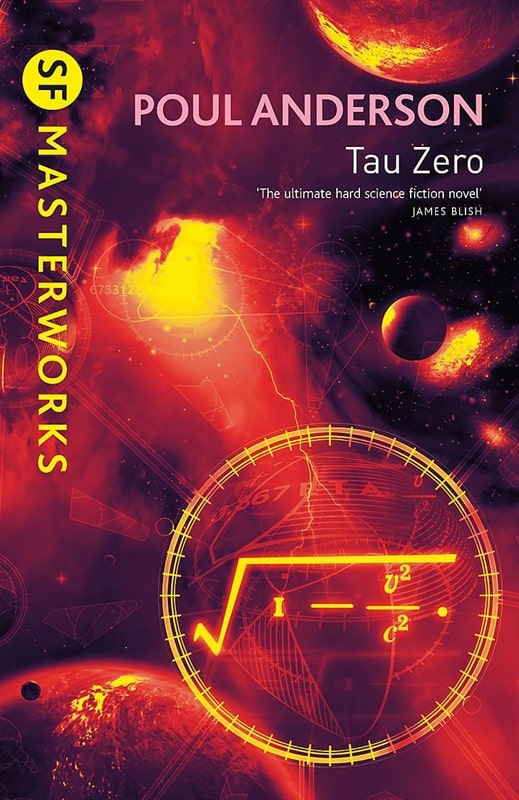 Tau Zero (Millennium/Gollancz SF Masterworks, February 2006). Cover by Dominic Harman
Tau Zero (Millennium/Gollancz SF Masterworks, February 2006). Cover by Dominic Harman
Science fiction — what is it, really? What elements place a story firmly in the genre? For any requirement that you can think of, there is probably a great sf story that violates it, and rather than cobble together some dictionary-ready definition, it’s easier to just think of particular books that you would hand to someone unacquainted with the genre with the words, “Here — read this; this is science fiction!”
Everyone would have their own choices for such a list, of course, and those choices would amount to your de facto definition. For me, some of those books would be Rendezvous with Rama by Arthur C. Clarke, The Stars My Destination by Alfred Bester, and Man Plus by Frederik Pohl, but the very first book on my list would be Poul Anderson’s 1970 novel Tau Zero. Why? What does this book have that makes it a quintessential work of science fiction?
Maybe it’s this — it’s a grand voyage, a brave excursion into the great out there, and it also has a grand perspective shift, like a camera pulling back in a movie, a maneuver that radically alters everything that you had previously thought about the story, something that’s not a minor adjustment, but a move that completely explodes the frame. You think the story is this, but it’s really that, you think you’re here, but you’re really there; the here where you thought you were turns out to be the tiniest corner of there, a there that is larger and stranger and more dizzying than you ever could have originally imagined. (In The Encyclopedia of Science Fiction, Peter Nicholls calls this kind of maneuver a “conceptual breakthrough.”)
Tau Zero begins as a straightforward story of an interstellar voyage, but it ends as far away from that prosaic beginning (prosaic by the standards of science fiction, I mean) as it is possible to imagine. Farther than that, really, and I think that’s the whole point.
Sometime in the 23rd century, the colonization ship Leonora Christine sets out from earth for a planet thirty light-years away. Unlike many stories of this type, the voyage isn’t prompted by the world coming apart at the seams; generally, things are going quite well, which is largely due to the people of the planet submitting to a global government run exclusively by… Scandinavians. Everyone just handed the reigns to the Nordic folk because of their universally acknowledged rationality, efficiency, impartiality, and lack of any pesky Will to Power. I know, I know — send any complaints to that son of Denmark, Poul Anderson. I guess he figured he would inoculate his readers against all the wildness to come by giving them the nuttiest thing first.
If the interstellar colonization mission is a stock situation, Anderson peoples it with characters that are themselves mostly recognizable types. The Leonora Christine’s Captain is Lars Telander, a solid, stolid, stoic father figure who seems ideal at the beginning of the journey, but who fades (if not wilts) into the background under the stresses of the voyage and the extraordinary emergency that the crew eventually has to deal with. More central to the life of the ship and the story Anderson tells are First Officer Ingrid Lindgren, ultra-competent while still being sensitive and sympathetic, and the book’s real protagonist, Ship’s Constable Charles Reymont, willing to be as much of an unlikable, hard-nosed SOB as necessary in order to hold the crew together and complete the mission. Reymont’s and Lindgren’s on-again, off-again romance and their consciously embraced good cop/bad cop roles form the human core of the story.
Anderson devotes significant time to this pair and to the other crew members whom they alternately coax (Lindgren) and steamroll (Reymont) on the way to their goal. In one sense, the book is a tract on the dynamics of leadership in a uniquely stressful situation, and the author had clearly thought a lot about such problems and had some definite ideas about how to deal with them.
It has to be said, however, that Anderson’s depiction of character rarely rises above a fairly rudimentary level; there’s an off-the-rack feel to most of his people. What we have here isn’t Henry James in space, and stylistically, the book wasn’t written to dazzle; if you’re looking for graceful allusiveness, poetic imagery or memorable turns of phrase, you need to look elsewhere; Anderson’s prose generally doesn’t rise above the level of “workmanlike” (which doesn’t mean that it’s bad — it usually has the far from negligible virtues of efficiency and clarity). So, old Poul is no Nabokov in space, either.
So what? Tab A in Slot B prose and slide-rule stiff characters are hard-sf traditions that go back all the way to the vacuum-busting days of Hugo Gernsback (and Anderson’s work isn’t nearly as wooden as the stuff old Hugo published), which just means that you adjust your expectations when you read this kind of sf story. (Oh, what’s a slide rule? Google it, kid.)
In the long run, Anderson’s deficiencies are perfectly acceptable because what you read Tau Zero for is the writer’s wide-screen vision and the extraordinary crisis his people face, and what a vision! What a crisis!
The Leonora Christine powers itself by collecting hydrogen as it travels through interstellar space and using it for fusion. (Technically this makes the ship a Bussard ramjet, though Anderson never uses the term.) As such a ship can approach the speed of light but cannot exceed it, the vessel’s flight plan is to accelerate up to near light speed during the first half of its voyage and then steadily decelerate down from that halfway point until it arrives at the target planet. Because of the relativistic time dilation caused by its extreme speeds, over thirty years will pass on earth while only five years will pass on board the ship.
Initially, things go smoothly as the crew settles into the routines that will occupy them during their long journey, and as expected, people (half of the multinational, fifty-person crew are male and half are female) begin to pair off in preparation for life as colonists on their new world. Everything seems to be going according to plan, until, before reaching the midway deceleration point, the Leonora Christine collides with an unanticipated interstellar dust cloud; because of the ship’s increased mass (due to its speed) this is potentially a very serious event, more like slamming into a brick wall than strolling through a fog bank.
At first, the ship seems to come through this emergency surprisingly well, but the truth soon becomes apparent. The collision has caused irreparable damage to one vital system — the one used for deceleration. The Leonora Christine is unable to slow down.
Why is the damage irreparable? To make repairs, it would be necessary to exit the ship, but the engines generate radiation that would be instantly fatal to anyone outside the hull, and the engines cannot be shut down because they generate an electromagnetic field which is the only thing protecting the crew from the hard radiation of galactic space. (The darn thing must not have been designed by Scandinavians.)
Reymont, Lindgren and the rest are thus faced with the prospect of an endless, pointless voyage that can only conclude with their own deaths from accident, old age or despair, sealed inside something that began as a ship, turned into a prison, and can only end as a coffin. Such an appalling situation would be bad enough, but the Leonora Christine’s crew soon comes to an even grimmer realization.
Unable to decelerate, the time dilation that was to have initially separated them from their home by a mere thirty years is only growing more extreme. The stunned crew members quickly realize that it is not decades that are passing outside the ship, not centuries, not millennia, even. “Soon”, millions, and then billions of years have passed. The would-be colonists whose aim was to open a new world for people from earth to live on must now accept that earth’s sun has long since burned to a cinder, their planet has vanished, their species has become extinct. The fifty exiles on the Leonora Christine are the last human beings alive in the universe, and unless they can find a solution to their dilemma, they are the last human beings that there will ever be.
How will they respond? Panic? Madness? Suicide? Reymont and Lindgren (especially Reymont) are resolved to hold the crew together, determined that they will all continue to do their jobs in the hope (hope being one of the defining characteristics of the late, great human race) that they will eventually find some way to slow down and locate some world, somewhere, where they can make a new start and keep their species alive.
Despite being more radically alone than any human beings have ever been (at one point, someone quotes Father Mapple from Moby Dick — “for what is man that he should live out the life-time of his God?”), for the most part, the Leonora Christine’s people respond well; the extreme strain sometimes produces extreme effects, but no one commits suicide. (I suspect that Anderson knew that in such a situation, if just one person took that way out, it would likely be the effective end of everyone.)
Soon they have left, not only our own galaxy, but also the supercluster of galaxies that constitute our local “neighborhood”, in the hope of reaching a region in which radiation levels will be low enough to permit them to make their repairs. As these “empty” gulfs are completely uncharted, they are also trusting that chance (or that God whom some of them still believe that they have not outlived) will eventually bring them to a galactic group where they will find a suitable planet.
Unexpected difficulties continue to intervene, however, and by the time they are able to fix the damage and decelerate to begin their search for a new home, there is no longer any potential home to decelerate to; so much time has passed outside the ship that the expansion of the universe caused by the original Big Bang has reversed. The universe is now contracting in a “Big Crunch” in which all matter and energy are forced closer and closer together until the cosmic cycle will restart with another Big Bang.
What is there for the Leonora Christine to do but circle the cosmic seed and attempt to ride out the coming explosion and then try to find a young world to begin again on? That’s just what they are able to do, and the story that began on an old planet in an old galaxy in an old universe ends on a new planet in a new galaxy in a universe that didn’t even exist when the story began, uncounted trillions of years before.
The book closes with Charles Reymont and Ingrid Lindgren, two people who now constitute one twenty-fifth of the entire human race, standing on the soil of the home they have travelled such an inconceivable distance in time and space to reach. “Here was not New Earth”, Anderson says. “That would have been too much to expect.” But it is a place where the stubborn, resourceful, endlessly hopeful human race will be able to start anew, a place where it will have a chance to take root and flourish… and perhaps, avoid some of the mistakes that plagued it long ago in a universe that now no longer exists.
Charles Reymont, the man whose determination saved the entire human race, lightly rejects the suggestion of kingship that Ingrid Lindgren jokingly (but also not entirely unseriously) makes, and then “he laughed, and made her laugh with him, and they were merely human.”
Pardon my French (a language once spoken on the long-extinct planet earth), but… holy shit!
Tau Zero was called by James Blish the “ultimate hard science fiction novel.” It’s certainly difficult to think of one that could go beyond it; every time I finish reading it, I want take my brain out, shake it a little, massage it, and run it under a cold faucet before putting it back in my skull. It’s a book that takes your perspective and stretches it, and stretches it, and keeps on stretching it until you walk around bumping into walls because you’re so far from where you started that you have no idea where you are anymore and can’t even begin to imagine where you’re going to end up when you’re finished.
Even in the science fiction genre, there aren’t many books like that. Even a lemon-sucking, hard line anti-Campbellian anti-sentimentalist like Barry Malzberg grew positively misty whenever he talked about the book. Calling the novel “magnificent”, Malzberg rhapsodized that Tau Zero was “the only work published after 1955 that can elicit from me some of the same responses I had towards science fiction in my adolescence — a sense of timelessness, human eternity, and the order of the cosmos as reflected in the individual fate of every person who would try to measure himself against these qualities.”
This wasn’t just Malzberg indulging in nostalgia; Poul Anderson’s book, which marries a modest nuts-and-bolts style with a beyond-audacious premise, really does what Malzberg says it does, and in doing so it goes beyond the merely mind-boggling; it squares the boggle and keeps on squaring it until you’re so dizzy with infinitely expanding possibility that you have to lie flat on the floor for a while. For me, it’s the wildest, most exhilarating trip in all of science fiction.
I’m not going to return to the definitional task that I disavowed when I began this piece, but I do know that one of the things that we most want from a science fiction story is that when we finish it, we won’t end up back where we started. We want it to take us on a voyage, the kind of voyage that no other kind of writing can accomplish or even attempt.
If you want to know what kind of voyage that might be, I can do no better than to turn you over to one of the genre’s greatest voyagers, Poul Anderson, and commend to you his indeed magnificent novel, Tau Zero. When you’ve finished reading it, you might just feel — along with me — that what you’ve been holding in your hands is nothing less than the beating heart of science fiction.
Thomas Parker is a native Southern Californian and a lifelong science fiction, fantasy, and mystery fan. When not corrupting the next generation as a fourth grade teacher, he collects Roger Corman movies, Silver Age comic books, Ace doubles, and despairing looks from his wife. His last article for us was The Gorey Century
7 Author Shoutouts | Authors We Love To Recommend
Here are 7 Author Shoutouts for this week. Find your favorite author or discover an…
The post 7 Author Shoutouts | Authors We Love To Recommend appeared first on LitStack.
Bet On Me, Daddy - Book Review by Voodoo Bride
What is it about:Years ago, I made a promise to myself. That I would never again put myself at the mercy of a man.
Especially a man as sinfully rich and gorgeous as Beckett Stone.
Until the day a stupid little bet put me exactly where I swore I’d never be again. On my knees, ready to surrender it all for two little words.
Good girl.
I keep telling myself it’s casual. Just a club fling I can walk away from whenever I want.
And I should. Walk away, that is.
Because I’m not the only one with a shattered past. The ghosts that haunt Beckett’s dark, brooding eyes tug at my heartstrings. They make me want to forget all the promises I’ve made for myself. To throw caution to the wind and beg him to take a chance on me. On us.
To beg him to Bet on Me, Daddy.
What did Voodoo Bride think of it:Although we mainly read Fantasy or SciFi, once in a while a Contemporary book catches my eye. I saw the author mention this book on social media, I went to investigate, saw that beard: had to get it!
And this is a delicious read.
I should warn the casual BDSM reader that this Romance has a Daddy/Brat relationship, be aware it's not just a little spanking when in the bedroom, but an all in lifestyle.
That out of the way: I loved the dynamics between Ruby and Beckett. They both feel a strong attraction toward each other, but both have their reasons to not want to commit to a relationship. As they decide to be 'casual' they soon are in over their heads though.
The viewpoint switches between the two so you get to see in both of their heads. I could easily understand them both, and rooted for them to open up and let the other inside. Add some seriously hot scenes and I could not put this book down.
You bet I'll be be getting my hands on the first book, and there's going to be a book/series about a side character who immediately drew my attention!
Why should you read it:It's a deliciously hot BDSM Romance
Snake Oil Bullet by Craig Schaefer (reviewed by Mihir Wanchoo)

Official Author Website
Order Snake Oil Bullet over HERE
Read Fantasy Book Critic's review of The Long Way Down
Read Fantasy Book Critic's review of The White Gold Score
Read Fantasy Book Critic's review of Redemption Song
Read Fantasy Book Critic's review of The Living End
Read Fantasy Book Critic's review of A Plain-Dealing Villain
Read Fantasy Book Critic's review of The Killing Floor Blues
Read Fantasy Book Critic's review of The Castle Doctrine
Read Fantasy Book Critic's review of Double Or Nothing
Read Fantasy Book Critic's review of The Neon Boneyard
Read Fantasy Book Critic's review of The Locust Job
Read Fantasy Book Critic’s review of Down Among the Dead Men
Read Fantasy Book Critic’s review of Dig Two Graves Read Fantasy Book Critic's review of Sworn To The Night
Read Fantasy Book Critic's review of Detonation Boulevard
Read Fantasy Book Critic's review of Winter's Reach
Read Fantasy Book Critic's review of The Instruments Of Control
Read Fantasy Book Critic's review of Harmony Black
Read Fantasy Book Critic's review of Red Knight Falling
Read Fantasy Book Critic's review of Glass Predator
Read Fantasy Book Critic's review of Cold Spectrum
Read Fantasy Book Critic's review of Right To The Kill
Read Fantasy Book Critic's review of Black Tie Required
Read Fantasy Book Critic’s review of Never Send Roses
Read Fantasy Book Critic's review of Ghosts Of Gotham
Read Fantasy Book Critic' review of A Time For Witches
Read Fantasy Book Critic's review of The Loot
Read Fantasy Book Critic's review of The Insider
Read Fantasy Book Critic’s review of Any Minor World
Read Fantasy Book Critic's Interview with Craig Schaefer
Read Fantasy Book Critic's Harmony Black Series Interview with Craig Schaefer
Read Double Or Nothing Cover Reveal Mini-Interview with Craig Schaefer
Read Part I of Fantasy Book Critic's In-depth Interview with Craig Schaefer
Read Part II of Fantasy Book Critic's In-depth Interview with Craig Schaefer
Read the Wisdom's Grave Trilogy Completion Interview with Craig Schaefer
Read the 2019 And Beyond Interview with Craig Schaefer
Read the Right To The Kill Cover Reveal Q&A with Craig Schaefer
Read the Black Tie Required Cover Reveal Q&A with Craig Schaefer
Read the Charlie McCabe series interview with Craig Schaefer
Read My Sworn To The Night Cover Reveal Q&A with Craig Schaefer
Read 2020 State Of Schaefer Interview with Craig Schaefer Read Celebrating A Decade Of Dark Fantastical Tales with Craig Schaefer
OVERVIEW/ANALYSIS: The Joker had quoted something intriguing in the Dark Knight “I believe that whatever doesn't kill you, simply makes you... stranger”. I don’t know if Heather Schaefer took this as a motto for Harmony Black to live by but it certainly seems to be a guiding statement for this series. Within the past three books Harmony, Jessie and team have had their backs against the wall, Harmony especially has had a horrid time with her powers being erratic as well.
Snake Oil Bullet deals with a lot of plot threads and characters from the past seven books. There’s not a lot I can say about the main plot without spoiling it but the least I can say that a certain doctor from book 7 makes his reappearance as well as other heinous villains from the team’s past. All in all this volume has a lot going on within. This is also a book which acts as a bookend to the second arc of the Harmony Black series while also setting up a tantalizing future.
I was thinking there would be a Hannibal Lecter-Clarice Starling going with Harmony and her tormentor-in-chief demon but the author neatly sidestepped this scenario and sets up something else. There’s also a lot of things that are revealed about Harmony’s past which set up future intrigue. The author has definitely settled the question of who the Paladin is but Harmony will have a huge part to play based on what is revealed about her heritage. This book has some interesting action sequences and the best part is the author’s usage of mirror opposites during the climax (you’ll know what I mean when you read the book).
The Vigilant Lock team has come a long way from where it started and with the end of the second arc. The author has shaken up the board and now things are moving slowly but surely towards the big Enemy-Paladin conflict that has been teased over both the Faust and Black series. Rest assured there will be plenty of alien & extra-dimensional trouble heading the team’s way and we the readers will be here to enjoy it. I also loved how incredibly intricate this series is with the First Story saga and yet has its own weird ongoings as well. The ending promises more carnage of both the personal and team kind but Jessie and Harmony are no pushovers either.
Snake Oil Bullet is a fun and twisted story that uses all the pillars which have been set up in the past and creates a dark canopy for readers to enjoy. The plot is streamlined, packed with action, and twisted reveals. As a fan this book helped satiate my Harmony Black cravings while giving me more to ponder. I can’t wait for more of Harmony and whichever title Heather releases next.
In the History of Vintage Science Fiction & Fantasy, Nothing Compares to Gnome Press
Isaac Asimov’s I, Robot and the Foundation Trilogy. Robert A. Heinlein’s Sixth Column. Arthur C. Clarke’s first three novels. The entire Conan saga from Robert E. Howard. The International Fantasy Award winner City by Clifford D. Simak. The Hugo Best Novel winner They’d Rather Be Right from Mack Clifton and Frank Riley. Books by L. Sprague de Camp and Fletcher Pratt, A. E. van Vogt, C. L. Moore and Henry Kuttner, Murray Leinster, Frederik Pohl, Jack Williamson, Andre Norton, and James Gunn.
Those would be a solid core of any collection of vintage f&sf. Yet those books and dozens of others appeared in a few years from just one small publisher: Gnome Press.
Fantasy had long been a staple of what we would now call mainstream publishing but before the 1940s American science fiction was relegated to gaudy pulp magazines, critically reviled as among the lowest forms of fiction. The superweapons that emerged from World War II, especially the atomic bomb, suddenly made the field look prescient, a look into the onrushing future.
 Windsor [ON] Star, November 2, 1946With mainstream publishers still reluctant to mine magazine back issues, fans of the genre saw a publishing niche. More than a dozen small presses sprang into mayfly-like existence before 1950.
Windsor [ON] Star, November 2, 1946With mainstream publishers still reluctant to mine magazine back issues, fans of the genre saw a publishing niche. More than a dozen small presses sprang into mayfly-like existence before 1950.
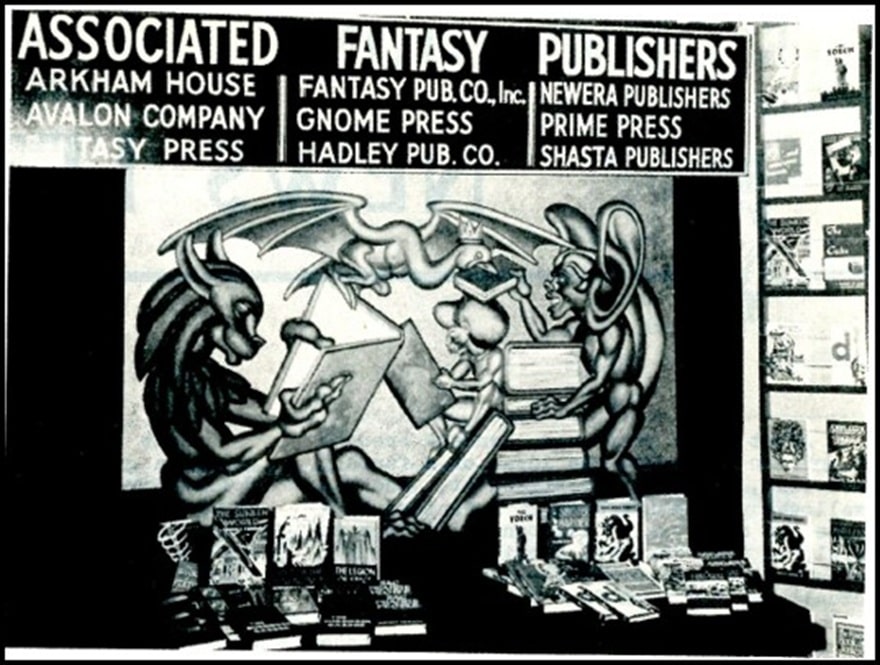 Bloomington News Letter fanzine, February 1949
Bloomington News Letter fanzine, February 1949
Gnome was founded in 1948 by two members of New York fandom, Martin Greenberg and David A. Kyle.
 The only known photo of Greenberg and Kyle together
The only known photo of Greenberg and Kyle together
Run on the proverbial shoestring, Gnome nevertheless outpublished, outsold, and outlasted all their competitors. Greenberg had a knack for making deals and Kyle did everything else, including drawing a half-dozen covers. He was soon obsoleted by young – and cheap – newcomers like Edd Cartier, Ed Emshwiller, and Frank Kelly Freas.
The firm made mistakes – could there be a worse response to the dawn of the Atomic Age than to drop three fantasies as its first three selections? – but quickly caught on to what the public wanted. Greenberg was a disciple of John W. Campbell who, whatever is thought of him today, then towered over the field as the guru editor of Astounding Science Fiction and Unknown Fantasy Fiction magazines. Whatever he touched, sold.
Greenberg used the magazines as his Comstock Lode and cannily offered to republish story series as “novels,” suiting post-war tastes if not the labeling laws. Authors flocked to Gnome’s door, desperately wanting hardback publication.
Well, that and money. Greenberg gave them only the former. He and Kyle split the proceeds fairly. Greenberg got a salary and Kyle didn’t. (Kyle always had multiple jobs and Greenberg had a family. But still.) Nevertheless, Kyle stayed six years and Gnome lasted fourteen, with Greenberg owing money to everyone in sight. He is usually described as a charming rogue with a gift of gab. Asimov once went to him demanding money and wound up lending more.
 Isaac Asimov royalty payments, auction catalog
Isaac Asimov royalty payments, auction catalog
History is never pretty. Flaws and all, nothing compares to Gnome in the history of vintage f&sf. In many ways, it is the history of vintage f&sf.
I knew nothing about Gnome when I chanced upon several titles in a used bookstore in 1980. I had seen the name in passing, but histories of the small presses were nonexistent. I found a list of all 86 titles, and dove in. A few decades later I had them all. Did I stop there? What fun would that be? Gnome produced about 75 variants, with different boards or different jackets. Nobody knows exactly how many, because new ones keep popping up. Finding all of them is essentially impossible, which means the search never has to end – the perfect collectible.
Moreover, Gnome published a variety of ephemera, from newsletters to catalogs to calendars and I set out to accumulate all that appeared on the market. I even bought the 1951 Fantasy Calendar, which was an unparalleled achievement since it doesn’t exist. (Blame Donald Wollheim.)
Digging for information is infinitely easier today than in 1980, yet Gnome appears to have left virtually no paper trail, an oddity for a publisher dealing every day with paper. Other than a few scraps at Syracuse University, no business records seem to have survived and not even the indefatigable Kyle bothered to talk much about his time at Gnome in the millions of words he wrote for fanzines.
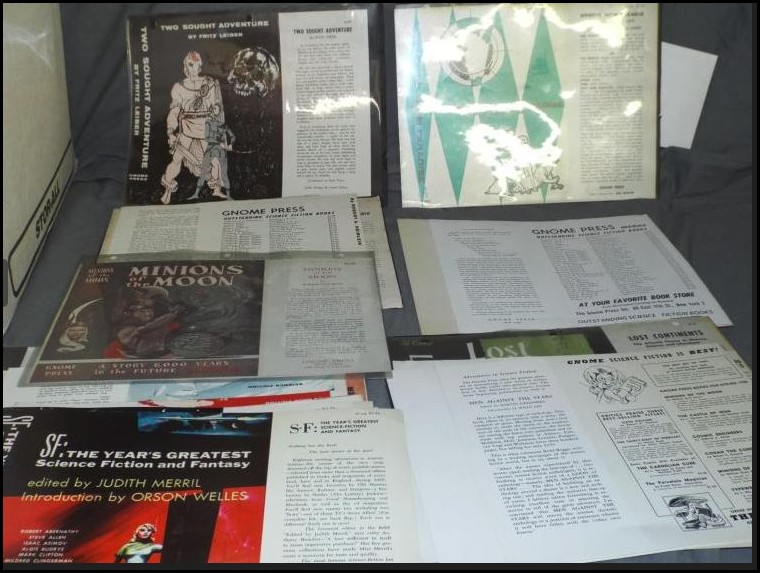 Gnome cover proofs, auction catalog
Gnome cover proofs, auction catalog
Nevertheless, dogged digging over decades created a repository of everything known about Gnome. Near archaeological level scrutiny of covers, flaps, copyright pages, and back panels yielded a history of each title. Each answered question led to ten additional mysteries. Eventually I wrote an utterly unpublishable 660-page manuscript dump that would require more than a thousand images to elucidate the text.
What’s 150,000 words and 1100 images to the internet? I already owned the URL GnomePress.com. The 113 pages there now comprise the first complete bibliography of Gnome Press (by author, title, and publication date), a separate page for each title with color scans of every variant board and cover I own along with contemporary reviews and previously unknown photos of the more obscure authors, information about a range of associational items, and histories both of Gnome and the f&sf field up to the time of its founding.
For all its literally exhausting coverage, the site remains a work in progress. Gnome collectors continue to provide information that require revision to opinions I previously thought firm. If anyone reading this has even the slightest scrap they want to share, please contact me. Or just ask questions about Gnome. Anything, except how much a book is worth.
By the way, Marty Greenberg’s file copy of I, Robot inscribed to him by Asimov is listed on the internet at $50,000. If you’re the buyer, please contact me. I want to know all about you.
Steve Carper is the author of hundreds of articles on fascinating, if obscure and forgotten, tidbits of history, as well as the seminal book Robots In American Popular Culture. All of his websites are linked at SteveCarper.com.
Teaser Tuesdays - Contagion
Rereading this for an online book club.

Ähhh." Cleaver said, but given the way his brow wrinkled, Lisbeth still wasn't certain he was following.
"There's nothing here," Sullivan growled.
(page 86, Contagion by Erin Bowman)
---------
Teaser Tuesdays is a weekly bookish meme, previously hosted by MizB of Should Be Reading. Anyone can play along! Just do the following: - Grab your current read - Open to a random page - Share two (2) “teaser” sentences from somewhere on that page BE CAREFUL NOT TO INCLUDE SPOILERS! (make sure that what you share doesn’t give too much away! You don’t want to ruin the book for others!) - Share the title & author, too, so that other TT participants can add the book to their TBR Lists if they like your teasers!
Book review: Old Soul by Susan Barker
 Book links: Amazon, Goodreads
Book links: Amazon, GoodreadsABOUT THE AUTHOR: SUSAN BARKER is the author of four books. Her third novel, The Incarnations, was a New York Times Editors’ Choice and Notable Book, a Kirkus Reviews’ Top Ten Book of the Year and shortlisted for the Kirkus Prize for Fiction. An excerpt from her fourth novel, Old Soul, won a Northern Writers’ Award for Fiction in 2020. Susan currently lives in Manchester, where she is a Senior Lecturer in Creative Writing at Manchester Metropolitan University.
Publisher: G.P. Putnam's Sons (January 28, 2025) Length: 352 pages, Hardcover Formats: Audiobook, ebook, hardcover, paperback
Old Soul is darker, sharper, and far more sophisticated than typical horror. No cheap thrills here - just an unnerving sense of inevitability creeping in with every page. Readers willing to handle a slow burn, a literary structure, and nuanced characters will love it.
The novel opens with two grieving strangers - Jake and Mariko - meeting in an Osaka airport. They share drinks and talk just to discover they both lost someone they loved under similar, rather horrific, circumstances. Their loved ones died thousands of miles apart, but each had met the same enigmatic, dark-haired woman beforehand. Oh, and one more thing - their internal organs were reversed.
From there, Jake starts a globe-spanning journey. Obsessed with the case, he’s collecting testimonies from people who’ve lost someone to the woman. Each of them reads like a miniature horror story.
Meanwhile, the woman herself is out in the Badlands, luring her next victim and she needs to hurry up. Immortality isn’t as glamorous as folklore would have you believe, and rotting from the inside is no fun.
The alternating perspectives - Jake’s investigation and the glimpses into the woman’s present build a slow, creeping dread. To me, this narration feels elegant and eerie. The horror here is intelligent, and creeping, with moments of near-cosmic dread. Despite the book’s sophistication, it never feels pretentious. It’s gripping and visceral and never gets lost in its own literary ambitions.
A few words about the mysterious woman. She is, without question, evil. But not in a theatrical way - there’s no excess, no unnecessary cruelty. She does what is required to survive and moves across centuries and continents under countless names, always ready to trade lives for immortality. She abandoned family long ago. Human connection, belonging - these are irrelevant. All that matters is survival. This relentless, almost inhuman focus makes her alien, but also fascinating.
Some books sink their teeth into you slowly. Old Soul goes straight for the bone. This is literary horror in the best sense - dark, sophisticated, and unsettling in a way that lingers long after you turn the last page.
Monday Musings: Thoughts After Visiting My Kid
Last week, I flew out to Colorado to visit, Erin. Now, it goes without saying that I will leap at any chance to have time with my Peanut. I don’t need excuses to visit. But in this case, we had a bit of an agenda. Erin was in need of a car, and I went out to help her with the purchase.
Yes, she is 25 years old and could have done all of it on her own. But here’s the thing. Statistics show that women, on average, pay more for cars — new and used — than do men. In fact, White men pay the least of all. Women and all people of color will, on average, pay more for the same car, in the same regions, and even at the same dealerships. This is not an imagined form of discrimination. This is real and documented and supported by data.
So, out to Denver I went. We found her a car at a decent price. She’s happy, and I had time with my darling girl.
 Erin in her new car!
Erin in her new car!
But . . .
The other night, I finally saw On The Basis of Sex, the Ruth Bader Ginsberg biopic that came out in 2018. The movie is, of course, a Hollywood take on an extraordinary historical figure, and so is bound to suffer from some flaws. But it offers an unstinting look at the barriers placed before RBG, who was always the smartest person in whatever room she entered, and always the best lawyer in any courtroom she graced. In this way, it reminded me of 42, the Jackie Robinson biopic starring the late Chadwick Boseman, and Hidden Figures, which told the stories of Katherine Johnson, Dorothy Vaughn, and Mary Jackson, Black NASA mathematicians whose revolutionary work helped make possible the American space program.
In all of these movies (and countless other similar films that I have failed to mention) we are reminded of the irrefutable truth that sexism and racism (as well as homophobia, religious bigotry, and discrimination against people with disabilities) create nearly insurmountable barriers to success for too many.
And this is the insidiousness of the current Administration’s hysterical and irrational assault on DEI programs across the country. The assumption underlying this “policy” is that white, cis, straight males are the standard that define what it means to be qualified and competent. This is, of course, utterly ridiculous, and to see how foolish it is, take a moment to read any online biography of General Charles Q. Brown, the former Chairman of the Joint Chiefs of Staff fired by the present occupant of the White House for no other reason than because he happens to be Black. For that matter, take a moment to read a biography of Admiral Linda Fagan, the first female commandant of the Coast Guard, or Admiral Lisa Franchetti, the first woman to serve as Chief of Naval Operations and thus the first female member of the Joint Chiefs. Both were fired, apparently, because they’re woman and, like Brown, were seen by the Administration as “DEI hires.”
As if the Administration itself isn’t filled with (and led by) hires that are based entirely on race and gender! Does anyone honestly think that Pete Hegseth would be Secretary of ANYTHING if he weren’t a straight White guy? Does anyone think that Donald Trump would be anything more than a two-bit grifter if he hadn’t been born White, male, and rich-as-fuck?
When I was in graduate school, my (white male) advisor told me the story of how he came to be hired as a history professor at Stanford. He happened to be in the office of his (white male) advisor when the (white male) chair of the history department at Stanford phoned the aforementioned advisor, who was an old pal from Yale. The history department chairman said, “We have an opening here for an American history professor. Do you have any grad students who are on the verge of finishing their dissertations?”
“Actually, I have one sitting right here, and he’d be perfect.” At that point, my advisor’s advisor turned the conversation over to my future advisor who was “interviewed” and hired on the spot.
They call it an Old Boys Network for a reason, and such advancement has long been available to White men across academia, as well as throughout the business world, the legal and medical professions, politics, and in pretty much every other professional realm imaginable. Was my advisor qualified for the job? Absolutely. Was he more qualified than anyone else — of any race, gender, or group — who might have sought the job at Stanford had it been advertised and thrown open to all properly credentialed applicants? Who knows?
DEI is not intended to give an unfair advantage to underrepresented groups. Rather it is intended as a corrective for a culture, society, and economic system that have been tilted in favor of White men literally for centuries.
And yes, I count myself among those who have benefited from that uneven playing field. Absolutely I do! I was born White, male, upper-middle class. I’m straight. I was given every opportunity to succeed — I grew up in a nice house, in a good school system, raised by parents who fed me well, kept me safe, and took an active role in my education. I was taught from an early age that being smart, and being perceived as smart, are good things. I never faced any social pressure to hide my intelligence in order to be deemed “more attractive,” as so many girls my age were. I never feared the police. I never was called by the “N” word, as my best friend was, in my presence, when we were twelve. When the time came, I was in an economic position that allowed me to attend an Ivy League university. What an advantage all of that was! My privilege set me up for success. I know this. And I deal with it the only way I know how: by being an ally to those who didn’t have my privilege, and by fighting (and voting) for social justice and economic equality at every opportunity. Yes, I’m Woke. You’re damn right I am.
The current Administration is attempting to reverse more than half a century of progress on women’s rights, Civil Rights, LGBTQ+ rights, and antipoverty efforts. Why? Because they see anything that further levels the playing field as being to their personal disadvantage. Many of their supporters feel the same way. They would rather perpetuate a system filled with bias, one that rewards mediocrity by limiting competition from qualified women, qualified people of color, qualified people with disabilities, qualified people who identify as queer. They are terrified by the surety that if forced to compete with a wider group of skilled, talented people, they are likely to lose out. And they’re probably right. But that doesn’t change the fact that they are pursuing an ideological agenda that is immoral, cruel, and bad for our country.
Wishing you a good week.
Spotlight on “A Palace Near the Wind” by Ai Jiang
“A Palace Near the Wind” by Ai Jiang is richly inventive, brutal and beautiful science-fantasy.…
The post Spotlight on “A Palace Near the Wind” by Ai Jiang appeared first on LitStack.
’24? in 42′ with…Bob Byrne????
Jason Waltz kicked off season two of his 24? in 42 podcast interviews with your very own Monday morning columnist. The prior installment was with Malazan’s Ian C. Esslemont, so I’m in pretty good company here.
It should not surprise you that I was all over the place, covering Robert E. Howard, Michael Moorcock, Columbo, books on writing and screenwriting, Encyclopedia Brown, the Civil War, Tolkien, The Constitutional Convention of 1787, Lawrence Block, Steven Hockensmith, Norbert Davis, and much more.
Jason sends sixteen questions ahead of time, and mixes in eight ‘new’ ones that can be definite curveballs. He started things off with a knuckleball! (Last week’s post was on baseball- I’m still in the mood)
Here are two sample questions:
Who is the visual artist(s) that creates the artwork that most moves you?Michael Whelan and Walter Velez (those terrific early Thieves World cover novels) are two of my favorite fantasy artists. Being a mystery guy, I LOVE some color paintings that Robert Fawcett did. Arthur Conan Doyle’s son Adrian (who waas a freeloading ass), co-wrote some Holmes stories. They’re not bad. All but the first appeared in Colliers’ illustrated by Fawcett. They are wonderful illustrations. Up there with the two great Holmes artists: Frederic Dorr Steele, and Sidney Paget. I find they capture Holmes.
How do you give depth to a character? Do you treat primary, secondary, and tertiary characters any differently?I consciously try to catch myself using a secondary or tertiary character as an info dump. Even a small one (and I absolutely do that). If the only reason I find them around is to give some info, I rework them. Or, try to use someone already in the story. There’s no depth to an info dump character.
The depth of a half dozen characters in the first Max Latin story (Watch Me Kill You) is about as well done as any story I’ve read. I try to give some personality, without making it a cliché.
Jason and I had a lot of fun, and you can actually see the enthusiasm that I bring to my blogging here at Black Gate. Settle in and watch (or at least listen) to me wax/ramble on. The 42 (from Douglas Adams’ Hitchhiker’s Guide) is the time target. Since I went over by about 35 minutes, I expanded on things a bit…
(42 is also Jackie Robinson’s number, and I talked about him for one question).
And for the record, since Jason called me out on camera: Ohio State defeated Texas in the CFP that night. In quite dramatic fashion, no less.
Click on over. I’m told I was a bit animated!

Bob Byrne’s ‘A (Black) Gat in the Hand’ made its Black Gate debut in 2018 and has returned every summer since.
His ‘The Public Life of Sherlock Holmes’ column ran every Monday morning at Black Gate from March, 2014 through March, 2017. And he irregularly posts on Rex Stout’s gargantuan detective in ‘Nero Wolfe’s Brownstone.’ He is a member of the Praed Street Irregulars, founded www.SolarPons.com (the only website dedicated to the ‘Sherlock Holmes of Praed Street’).
He organized Black Gate’s award-nominated ‘Discovering Robert E. Howard’ series, as well as the award-winning ‘Hither Came Conan’ series. Which is now part of THE Definitive guide to Conan. He also organized 2023’s ‘Talking Tolkien.’
He has contributed stories to The MX Book of New Sherlock Holmes Stories — Parts III, IV, V, VI, XXI, and XXXIII.
He has written introductions for Steeger Books, and appeared in several magazines, including Black Mask, Sherlock Holmes Mystery Magazine, The Strand Magazine, and Sherlock Magazine.
Book Review: The Gate of the Feral Gods by Matt Dinniman
I received a review copy from the publisher. This does not affect the contents of my review and all opinions are my own.
 The Gate of the Feral Gods by Matt Dinniman
The Gate of the Feral Gods by Matt Dinniman
Mogsy’s Rating: 5 of 5 stars
Genre: Fantasy, Science Fiction
Series: Book 4 of Dungeon Crawler Carl
Publisher: Ace (March 11, 2025)
Length: 608 pages
Author Information: Website
There’s LitRPG, and then there’s Dungeon Crawler Carl. In fact, Matt Dinniman may have forever ruined this genre for me, as I don’t think I’ll ever find a series as fun and amazing. The Gate of the Feral Gods is the fourth installment, but there’s no slowing down here. Instead, we’re charging full steam ahead, plunging deeper into the chaos!
The story picks right up from where things left off in The Dungeon Anarchist’s Cookbook, joining Carl and his larger-than-life feline companion, Princess Donut, as they descend deeper into the dungeon in their continued fight for survival. Now on the fifth floor, the rules shift dramatically, presenting an entirely new set of challenges. This level introduces a unique twist: all crawlers are separated into individual biome-themed “bubbles” which are scattered across four quadrants of the game world. Unfortunately for Carl and Donut, this means being cut off from their friends, and to make matters worse, they won’t be able to access the next floor until all the objectives in their bubble are met. As this is not something they can do on their own, success hinges upon finding new allies—and fast.
By now, we’re starting to see a pattern emerge, with each level introducing a distinct gaming mechanic. In many ways, the fifth floor mirrors an epic game of Capture the Flag, in which crawlers are randomly assigned to the different bubbles, such as air, water, land, and deep ocean. Each biome also features their own set of dangers, mobs, and goals. The only way to break free is to destroy the castles in their respective bubbles, which would then allow crawlers to assist others in doing the same. But of course, Carl, Donut, and their new party member Katia have landed in one of the toughest bubbles, where the challenges are more difficult and the odds against them are stacked higher than ever. Still, as we all know, it will take much more than that to break their spirit.
The Gate of the Feral Gods was yet another fantastic sequel, and I just love cracking open each book to discover what awesome adventure awaits us next. What makes these books so addictive and so entertaining is the way each volume builds upon the ones that came before, driving up the excitement while still maintaining the humor, heart, and thrilling action. These books are laugh-out-loud funny, and I’m always surprised at Carl’s ingenious solutions to seemingly impossible situations. I’m also floored by the sheer creativity in everything from small-scale puzzles in the dungeon to the overarching intrigue of who or what in the great wide universe is actually in control of the crawl.
It’s honestly impressive how Dinniman can manage to juggle so many moving pieces of the storyline all at once. You’ve got multiple character arcs unfolding simultaneously, all their interconnected plotlines, a dungeon and its AI that are constantly shifting in new and unexpected ways, various RPG mechanics that are expanding as the characters get stronger, plus an intergalactic political drama playing out in the background to boot! Whew! With so much happening at once, one thing for sure is that you’ll never be bored, and what’s more, each storyline is given the time and attention it deserves. True, sometimes things can feel a little overwhelming, but so far, the author seems quite diligent in resolving story threads so that readers aren’t left hanging.
But truly, what sets Dungeon Crawler Carl apart is its character development. Yes, we get new quest lines, new boss fights, and plenty of the crazy-ass dungeon-crawling mayhem that can only come from the mind of Matt Dinniman, but we also get to see Carl and Donut’s relationships evolve—both with each other and with the ever-expanding cast of allies and adversaries. In some ways, this series has the feel of a favorite soap opera, where I just can’t wait to dive back in to catch up with all the characters.
That said, things get pretty bleak for some of them. It’s a sad fact that none of the side characters are truly safe, and even Carl and Donut get put through the wringer, as they adapt to increasingly cruel and brutal challenges. Our protagonist has repeatedly sworn that the dungeon will not break him, but with each new level, the physical and psychological toll on him only seems to get worse. Still, whenever circumstances start to look dire, there’s always much needed levity to pull us out—often thanks to Donut and her impeccable talent for saying the most absurd things at the most inopportune times.
When all is said and done, I think The Gate of the Feral Gods might be my favorite book of the series so far, delivering on every front and exceeding expectations in every way. This book has everything readers love about Dungeon Crawler Carl—pulse-pounding action, gut-busting humor, and surprisingly deep emotional moments—all wrapped up in an explosive plot that’s impossible to put down. It’s a must read for fans, obviously. And if you haven’t started this series yet, don’t wait! With the re-issuing of all the books, there’s no better time to jump in.
![]()
![]()
More on The BiblioSanctum:
Review of Dungeon Crawler Carl (Book 1)
Review of Carl’s Doomsday Scenario (Book 2)
Review of The Dungeon Anarchist’s Cookbook (Book 3)
New Adventures for the World’s Favorite Barbarian
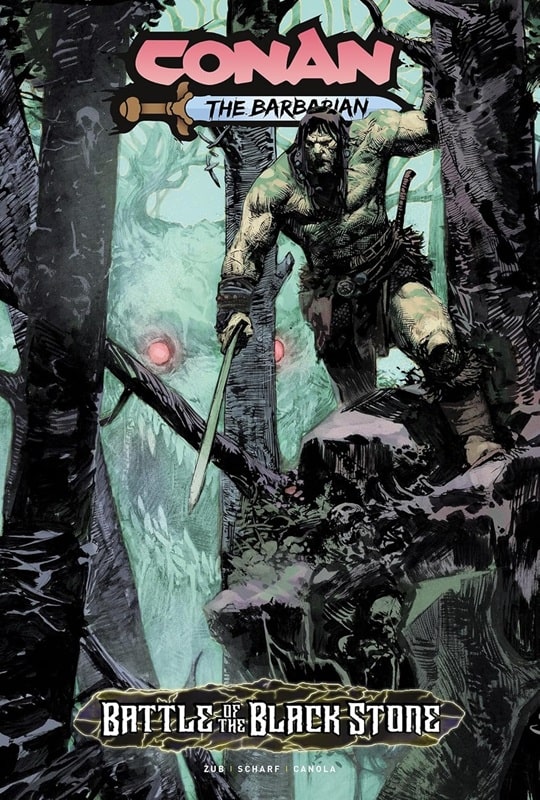 Conan the Barbarian: Battle of The Black Stone (Titan Comics collected edition, April 1, 2025). Cover by Jonas Scharf
Conan the Barbarian: Battle of The Black Stone (Titan Comics collected edition, April 1, 2025). Cover by Jonas Scharf
Few things are more ubiquitous than Conan and fantasy. Decades of sword-swinging high adventure has earned the barbarian a following most can only dream of. It’s taken the heavily thewed warrior to the big screen, Marvel Comics, and more. But it’s his latest adventure at Titan Comics that may prove to be the icing on the proverbial Shadizarian cake.
“This isn’t my first time writing Conan, but it’s definitely the most expansive opportunity I’ve ever had to chart the direction of such an amazing iconic character. I could not be happier in terms of our team and the collaboration we have in terms of story, art, and worldbuilding,” Jim Zub, writer of Conan the Barbarian at Titan Comics, shared by email.
[Click the images for Conan-sized versions.]
Over the years, few have come to understand the Cimmerian like the acclaimed Canadian scribe. Even in a career that has taken him to the heights of the comic book industry, Zub’s Conan work is special. His bibliography reads like a tour of the barbarian’s finest adventures of the past 10 years: Marvel’s Conan the Barbarian, The Savage Sword of Conan, and the epic Battle of the Black Stone are a few highlights. No wonder he’s so trusted by the rights holders of Robert E. Howard’s work.
“I actually work directly for Heroic Signatures, the rights holders of Conan and the Robert E. Howard character library. Titan publishes the comics in English, and they’ve been great publishing partners, but on a creative level I answer directly to the people who know Conan best and that has made the creative process really vibrant,” Zub stated.
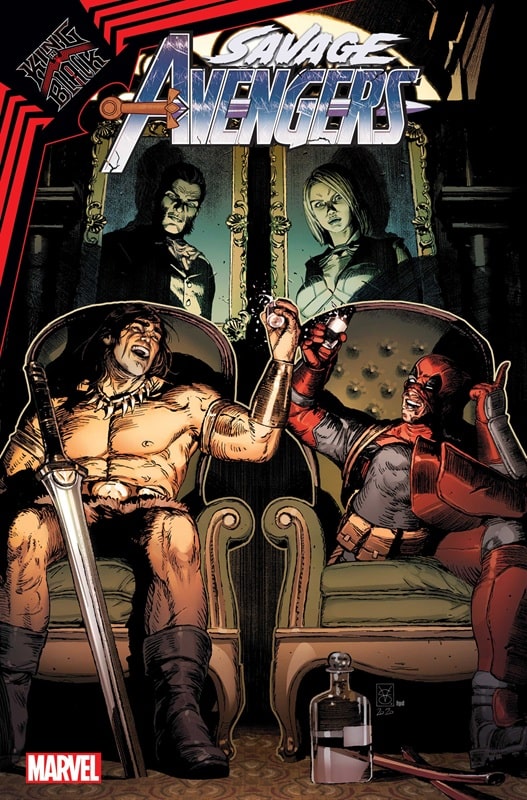 Conan and Deadpool in Savage Avengers #18, by Gerry Duggan and Kev Walker (Marvel Comics, February 17, 2021). Cover by Valerio Giangiordano
Conan and Deadpool in Savage Avengers #18, by Gerry Duggan and Kev Walker (Marvel Comics, February 17, 2021). Cover by Valerio Giangiordano
It wouldn’t be exactly fair to call Conan’s return to Titan a comeback. At Marvel, the Cimmerian had an impressive run in the much-loved Savage Avengers. Solo, he would be well-treated by Zub and his colleagues in stories like Conan: Serpent War and even fight symbiotes during the massive King in Black storyline. A look at the enthusiasm that has greeted Titan’s Conan series, however, tells you that this is something different.
Zub added, “Every time I get to contribute to characters and worlds I grew up with it’s a thrill, and this Conan publishing initiative is a whole new level.”
Such big breaks come with a heavy responsibility. After Howard created the character in the 1930s, many other writers would pen new tales for the Cimmerian. That lengthy list of scribes includes respected names like L. Sprague de Camp, Karl Edward Wagner, Roy Thomas, and Jason Aaron. How has he managed to stand out while writing a legacy character that has passed through so many legendary hands? Surprisingly, it’s by following the legends as closely as he can.
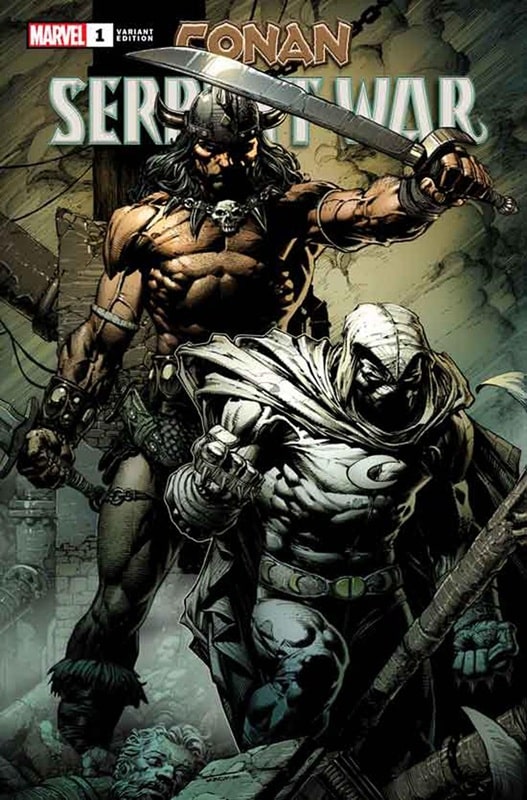 Conan: Serpent War #1, written by Jim Zub (Marvel Comics, December 4, 2019). Incentive variant cover E by David Finch
Conan: Serpent War #1, written by Jim Zub (Marvel Comics, December 4, 2019). Incentive variant cover E by David Finch
“If anything, I’m trying to hew as closely to Robert E. Howard’s original pulp characteristics as I can, while also incorporating the most iconic aspects of Roy Thomas’ seminal comic writing alongside the vision so many incredible artists like Frank Frazetta, Barry Windsor-Smith, John Buscema, Joe Jusko, Cary Nord and others have brought into it over the decades,” Zub explained.
Following in those footsteps brings with it plenty of challenges and opportunities. There aren’t many writers that understand that as well as Zub.
“The longer a character has been around, obviously, the more stories have been told and the harder it can be to surprise the existing fanbase while still staying true to who that character is. It’s a delicate balance where you want to keep core elements in mind but not close yourself off to new ideas,” Zub said. “The upside, of course, is the fact that legacy characters have that built-in recognition. I’m not building from scratch in terms of visibility and there’s an existing fanbase excited to see what comes next. The challenges and benefits are tightly wound together.”
You only need to read the massive Conan: Battle of the Black Stone limited series to see that approach in practice.
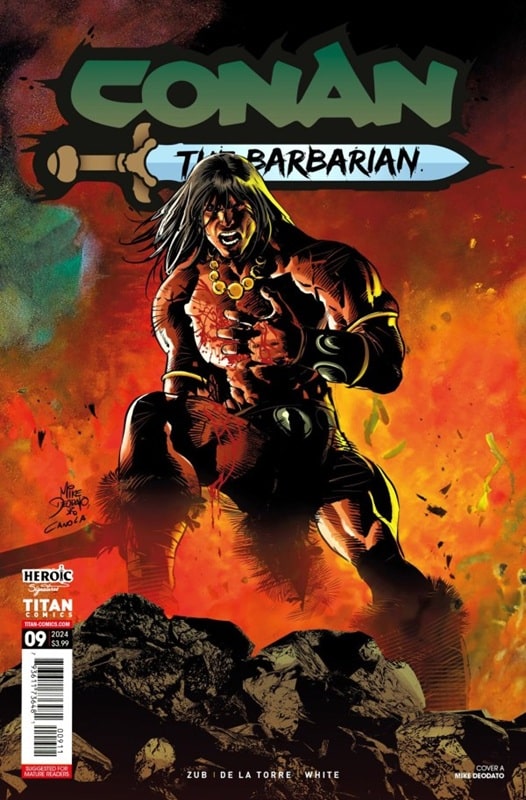 Conan the Barbarian #9, written by Jim Zub; art by Robert De La Torre and Dean White (Titan Comics, March 27, 2024)
A Walk With Titan
Conan the Barbarian #9, written by Jim Zub; art by Robert De La Torre and Dean White (Titan Comics, March 27, 2024)
A Walk With Titan
If one word could describe what it is like to read Titan Comics Conan the Barbarian, that word would be ‘fun.’ Not that it shortchanges readers on the artistic or deeper side of things. Far from it. The colors pop like a 70s comic, there’s no shortage of poetic allusions, well-crafted narrations, and action. But above all its bursting with creative energy, like a room of Conan’s most talented fans were allowed to cut loose.
“The new Titan series is a Mature Readers book, so we don’t have to hold back on violence or salacious elements where appropriate. That allows us to channel the intensity of the pulp source material even more closely,” is how Zub describes it.
Fans of high-fantasy and the barbarian’s sword-swinging antics will not be disappointed. Conan is at his most lethal in many of these stories, battling Picts and challenging sorcerers with his usual bravado. The ingredients of great sword and sorcery tales are all there: magic, romance, and plenty of mayhem.
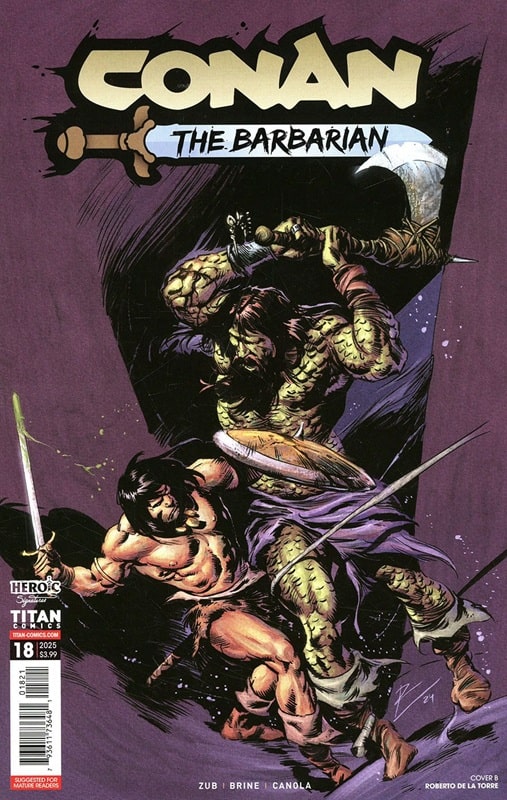 Conan the Barbarian #18, written by Jim Zub; art by Danica Brine and Joao Canola (Titan Comics, February 19, 2025). Cover B by De La Torre
Conan the Barbarian #18, written by Jim Zub; art by Danica Brine and Joao Canola (Titan Comics, February 19, 2025). Cover B by De La Torre
“It’s about distilling the best parts of past works and bringing them together with Howard’s own expansive mythmaking across the ages to tell epic stories of sword & sorcery. If I do my job well, it should feel “true” to old and new readers without falling back on adapting previous stories,” Zub said.
True to their epic vision, the creative team behind the series has not stopped at just celebrating the Hyborian Age. While the comics are full of respectful nods to the past, they also give Conan plenty of new obstacles to overcome. Other Howard characters are brought in and before you know it, a sprawling multi-timeline adventure is unfolding. Working on Conan, in general, has helped Zub level-up as a writer and his Titan Comics storylines feel like years of hard-work distilled for our reading pleasure.
“With each new storyline I’m pushing myself to use familiar pieces in unorthodox ways so that readers can see enough of the familiar to know that it’s still Conan, but knot know exactly which way the story is headed,” Zub said.
His evocative narrations have become integral to the experience. They set the tone, heighten the drama when necessary, and add some appreciated literary flair. It is no accident either that they read so quintessentially Conan.
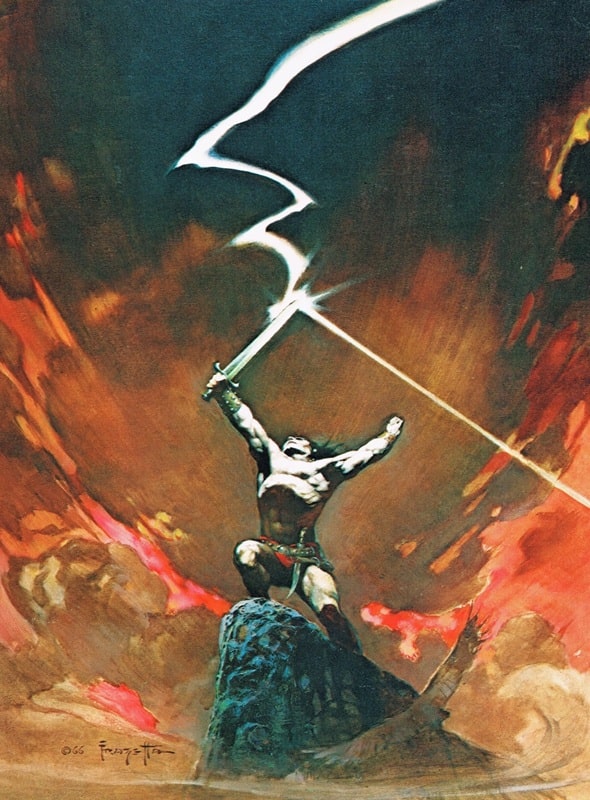 Classic barbarian art by Frank Frazetta: the cover to Thongor Against the Gods by Lin Carter (Paperback Library, November 1967)
Classic barbarian art by Frank Frazetta: the cover to Thongor Against the Gods by Lin Carter (Paperback Library, November 1967)
“I’ve marinated in the original Howard prose and analyzed it for cadence and vocabulary to make my narration feel like the classics without just copying it word-for-word. It’s made me think deeper about pacing, prose, characterization, geography, and culture,” Zub said.
The Battle for the Black Stone storyline has been a wild ride to say the least. While it’s impossible say where Conan is heading next, Zub’s work has left creatives of every level with plenty to learn from.
“There’s a reason why characters like Conan have stood the test of time and it’s crucial for people working on the property to understand and respect that bedrock foundation even while they bring their new ideas into the mix. Longtime fans can always tell if someone has done the research and cares about what they’re working on and, if you can win them over, it’s easier to build a strong audience from there,” Zub stated.
Ismail D. Soldan is an author, journalist, and poet. His work has previously appeared in Illustrated Worlds, LatineLit, and The Acentos Review among other publications. A proud explorer of both real and imagined worlds, his most recently published short story can be read in the January 2025 issue of Crimson Quill Quarterly, and his last article for Black Gate was An Eternal Champion’s Legacy.
The Leaning Pile of Books
The Leaning Pile of Books is a feature in which I highlight books I got over the last week that sound interesting—old or new, bought or received in the mail for review consideration. Since I hope you will find new books you’re interested in reading in these posts, I try to be as informative as possible. If I can find them, links to excerpts, author’s websites, and places where you can find more information on the book are included, along […]
The post The Leaning Pile of Books first appeared on Fantasy Cafe.Fan of the Cave Bear
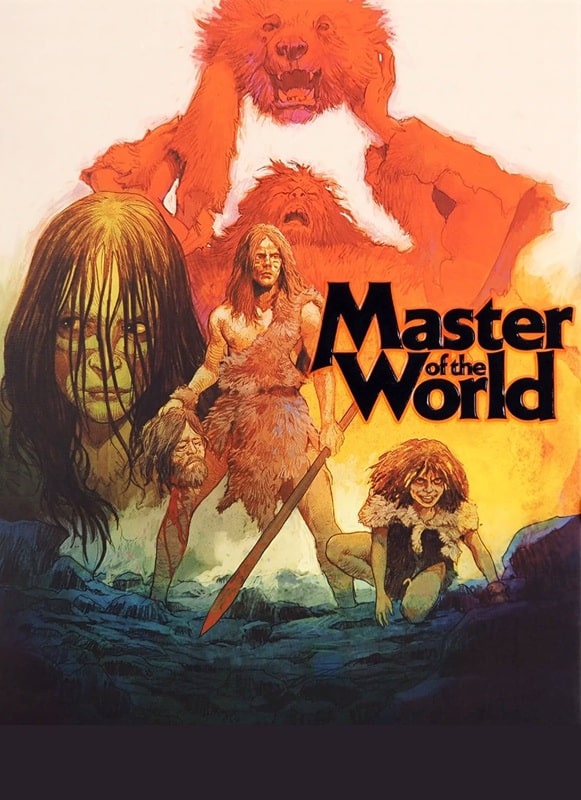 Master of the World (Falco Film, 1983)
Master of the World (Falco Film, 1983)
As usual, 20 films, all free to stream, and I’ve never seen them before. Can I really find 20 cave person films I can sit through?
EDIT: No. I’ve expanded the list to include any and all primitive cultures as there are not enough prehistoric flicks to watch.
EDIT: I’m capping this list at 10 – I can’t stomach any more f**king Italian cannibal flicks.
Master of the World (1983) TubiAgainst my better judgement, I’m starting a new list. The usual rules apply — 20 films, free to stream, based on a theme. This time, cave folk!
We kick off with this Italian offering from the early 80’s, obviously inspired by Quest for Fire and, um, possibly Caveman. It’s the old story of forbidden love, rival clans beating each other up and eating the brains of the vanquished, plus the invention of the bolas. It’s the Romeo and Juliet adaptation you never knew you needed.
The whole shebang is peppered with grainy stock footage of out-of-place animals and clouds, and there’s a man in a bear suit intercut with a real, heavily drugged bear, who beats the crap out of everyone. Actually, this semi-fake bear was a highlight.
As any nerd worth their salt will tell you, Ben Burtt used the sounds of a bear to create Chewbacca’s guttural growls. I swear to God, the filmmakers just took soundbites of Chewbacca from Star Wars and dubbed their own bear with them. Check it out — validate me!
Ultimately, a rather tedious affair, too much high-pitched grunting. I’m only one film in, and already regretting this.
3/10
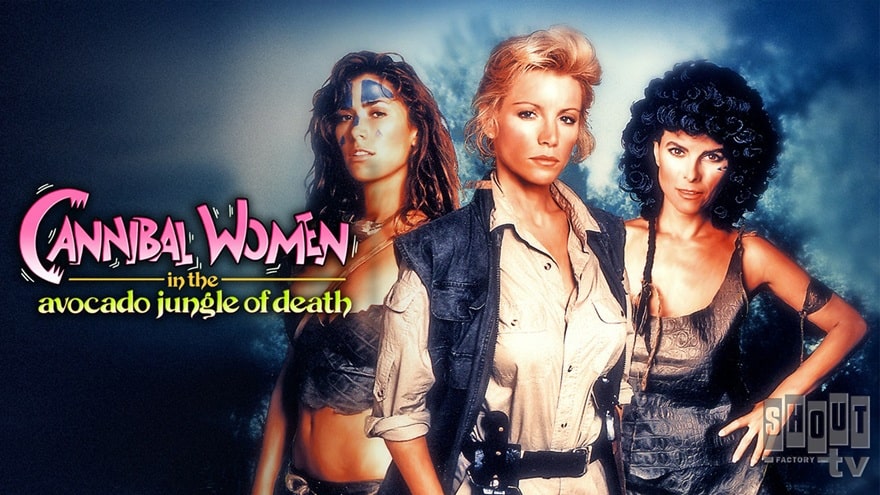 Cannibal Women in the Avocado Jungle of Death (Paramount Home Video, 1989)
Cannibal Women in the Avocado Jungle of Death (1989) Tubi
Cannibal Women in the Avocado Jungle of Death (Paramount Home Video, 1989)
Cannibal Women in the Avocado Jungle of Death (1989) Tubi
Confession: I could only find about a half dozen prehistoric cave people flicks (that I hadn’t seen or are free to stream), so I have expanded the parameters to include any ‘primitive’ cultures or groups. This opens up the doors for a wider selection, and a lot more rubbish. Case in point…
I thought I had seen this, but I was probably confusing it with Amazon Women on the Moon — anyhoo, this is a weird little affair, very cheaply made, and a bit of a mess. I’ve seen it described as a comedy horror, but there’s no horror in it, and very little in the way of good comedy. The script, written by director J.F. Lawton (who wrote Pretty Woman and Under Siege!) is really not as funny as he thinks it is, flip-flopping between absurdist schtick in the Airplane vein, to satirical monologues — all of which outstay their welcome very quickly.
Shannon Tweed is perfectly fine as the lead, but Adrienne Barbeau is wasted, and the least said about Bill Maher the better (although he does nail a couple of pratfalls). The film claims to be a commentary on feminism and toxic masculinity, but neither theme is realised due the reliance on tired tropes (the male gaze, the white male savior). Oh well.
4/10
 The Slime People (Donald J. Hansen Enterprises, 1963)
The Slime People (1963) Prime
The Slime People (Donald J. Hansen Enterprises, 1963)
The Slime People (1963) Prime
A primitive prehistoric race rises from the sewers to reclaim the planet after some misguided nuclear testing? Yes, this fits the criteria.
Is it any good though? Weeeellll…
It starts off pretty well. A lone pilot flies into a California airport, only to find the entire town deserted. It’s well set up, and would be even more effective if the film hadn’t shown us the titular monsters as soon as the film starts, before the credits. The monsters themselves are quite interesting, however it looks like they blew the budget on three full-size costumes; think Dr. Who‘s Zygons wearing gorilla pants.
The rest of the ensemble is made up of the usual suspects: lantern-jawed Clark Gable-lite, useless scientist, useless scientist’s useless daughters, useless marine (only there to say ‘gee whiz’ and kiss a useless daughter) and a nutcase who has ‘uncomfortable feelings’ for his goat. You read that right.
The whole affair is shrouded in fog (a major plot point) as mostly consists of lots of talking and running through the afore-mentioned fog. It’s a bit rubbish, but strangely compelling.
5/10
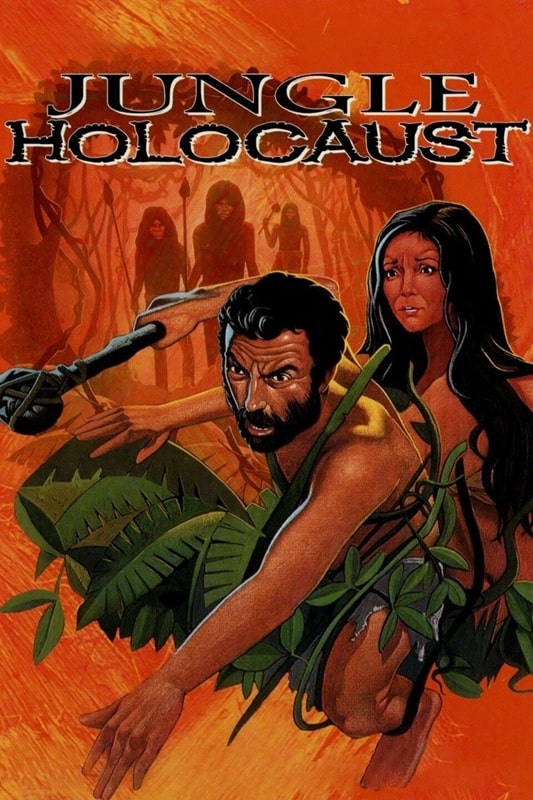 Jungle Holocaust (Erre Cinematografica, 1977)
Jungle Holocaust (1977) Tubi
Jungle Holocaust (Erre Cinematografica, 1977)
Jungle Holocaust (1977) Tubi
Of all the horror sub-genres, jungle cannibal ones are my least favourite. There’s simply no joy to be found in any of them, and combine them with the Italian predilection for animal cruelty, and you’ve got a film I never need to see twice. This one is the first foray into the genre by the much lauded Ruggero Deodato, and it’s not as ghastly as his later offerings, but still enough to leave me questioning my life choices. I can deal with the human-on-human buffets, but the suffering of real animals turns my stomach.
Anyhoo — it’s the usual plot; white Italians enter the jungle, get eaten. Along the way there is stock footage of animals eating each other, ants in wounds, copious willy tugging (some bad, some good) and lots of ‘oo, oo, oo’ ‘aah, aah, aah’.
The leads are pretty good, Massimo Foschi really sells the whole jungle madness look, and Me Me Lai is great as the loveliest cannibal of them all. However, at the end of the day I don’t mean to be judgemental, but I have no idea how anyone can watch these for a good time.
6/10
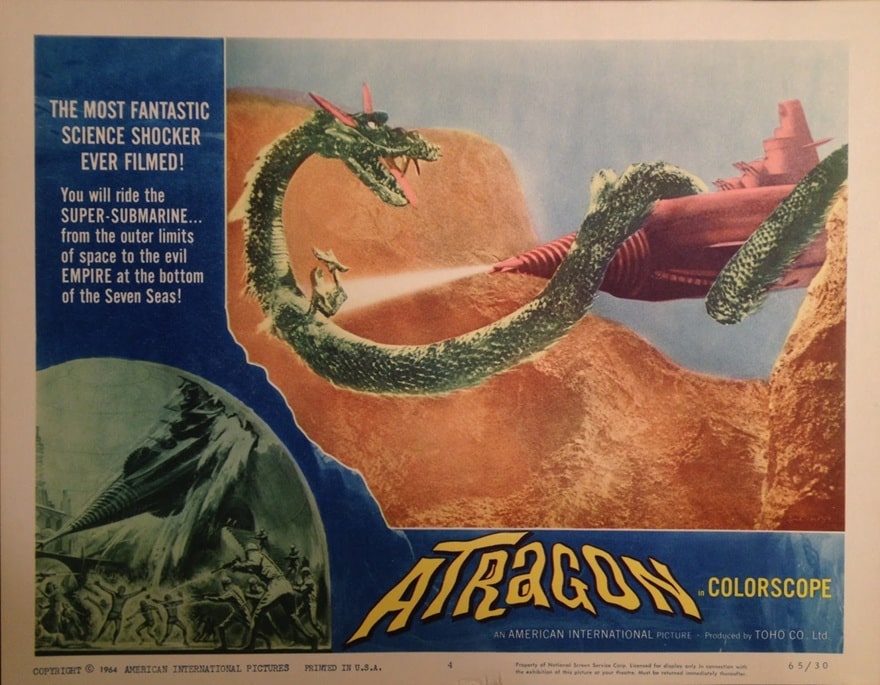 Atragon (Toho, December 22, 1963)
Atragon (1963) Prime
Atragon (Toho, December 22, 1963)
Atragon (1963) Prime
A tenuous fit for this project, Atragon features an ancient civilization (the Empire of Mu) hellbent on reclaiming their position as rulers of the world. For now, their continent lays at the bottom of the Pacific, so the film is all about Japan’s experimental submarine program, patriotism, and nefarious agents.
The entire world rallies via stock footage as the Mu Nemo themselves around the globe, sinking ships and being a general nuisance. Lots of lovely matte paintings and Thunderbirds-style models, and a bonus sea monster at the end. I had fun.
6/10
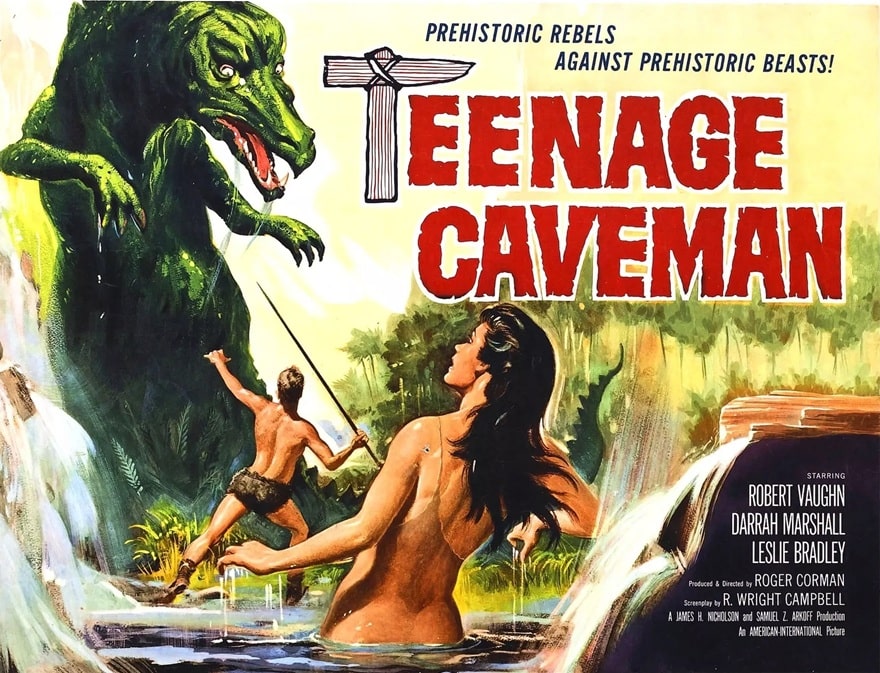 Teenage Caveman (American International Pictures, July 1, 1958)
Teenage Caveman (1958) Prime (AMC+)
Teenage Caveman (American International Pictures, July 1, 1958)
Teenage Caveman (1958) Prime (AMC+)
Yes, I started a free 30-day trial sub to AMC+ just so that I could watch this movie without the MST3K voice track. Such is my commitment to this pointless exercise in procrastination.
Anyhoo — here we have Roger Corman writing and banging out a caveman film in a couple of weeks. All shot on one California location, amply sprinkled with footage from other AIP flicks, featuring a very young Robert Vaughn as a young ‘cave person’ in the midst of an existential crisis. The clan he belongs to is the cleanest, whitest bunch of knuckle-draggers you’ve ever seen, and their hair is perfect. They all adhere to a bunch of rules attributed to Sky Gods and Monsters (TM), but Bobby Vaughn ain’t down with no rules, daddio.
He rebels, as all teens should, and while the elders sit around at camp discussing the rules, he goes out to see what’s so dangerous about the other side of the river. Here’s the thing, despite it being cheesy as hell, and somewhat laughable, Vaughn plays it straight (the right choice) and Corman clubs us around the head with a killer twist. I rather enjoyed it. Second film to feature a dude in a bear costume too, so it gains back the mark I was about to take away for the cruel real animal fighting.
6/10
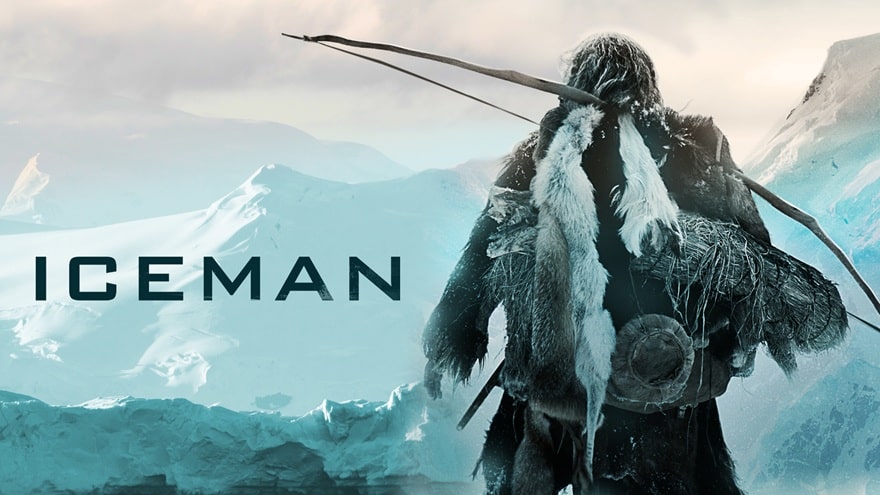 Iceman (Echo Film/Lucky Bird Pictures, 2017)
Iceman (2017) Tubi
Iceman (Echo Film/Lucky Bird Pictures, 2017)
Iceman (2017) Tubi
Based on a 5300-yr-old mummy found by hikers in 1991, this German production proceeds to tell the imagined last days of a Neanderthal man, Kaleb. It’s a simple revenge flick, told in the ancient Rhaetic language, and is beautifully shot through with a suitably grim palette.
Jürgen Vogel as Kaleb is brilliant, bringing physical and emotional heft to every scene, and it was a treat to see Franco Nero pop up. It’s solid, at times horrific, and a reminder that revenge is a dish best served hunted, skinned and roasted.
8/10
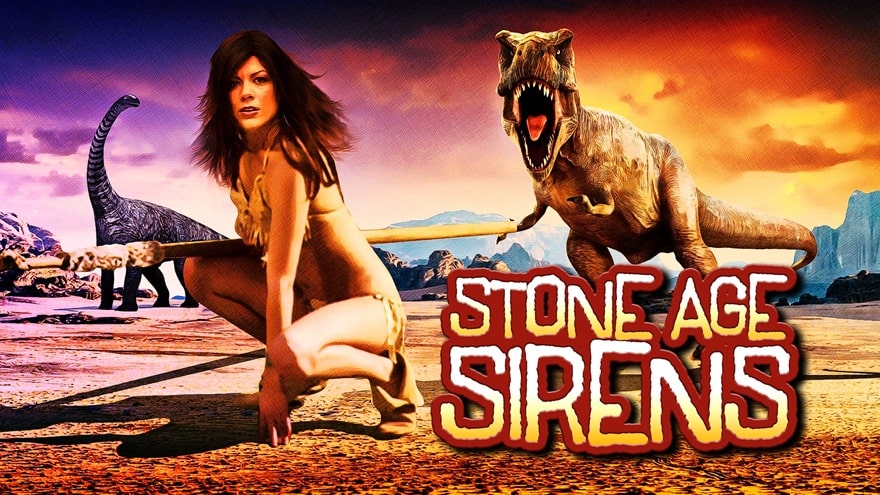 Stone Age Sirens (Retromedia Entertainment, November 16, 2004)
Stone Age Sirens (2004) Tubi
Stone Age Sirens (Retromedia Entertainment, November 16, 2004)
Stone Age Sirens (2004) Tubi
Another Fred Olen Ray flick (credited as Nicholas Medina, his soft-core pseudonym), this one is a heavily edited version of the film Teenage Cave Girl, heavily edited to the point where there’s no actual Neanderthal nookie on display at all. By cutting out all the sex scenes, what you are left with is a rubbish comedy about a pair of cave dwellers who are transported to the future and fall in with some randy archeologists (there’s more than you knew).
Peppered with stop-mo shots stolen from Planet of the Dinosaurs and some abominable CG in all its 8-bit glory, this is the usual slice of fried shite I’ve come to expect from the once great Ray. It gets a point for only being 46 minutes long.
1/10
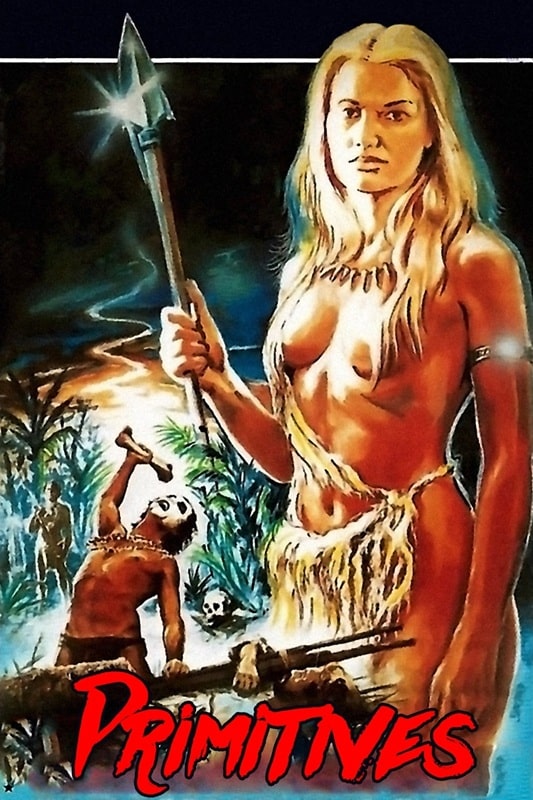
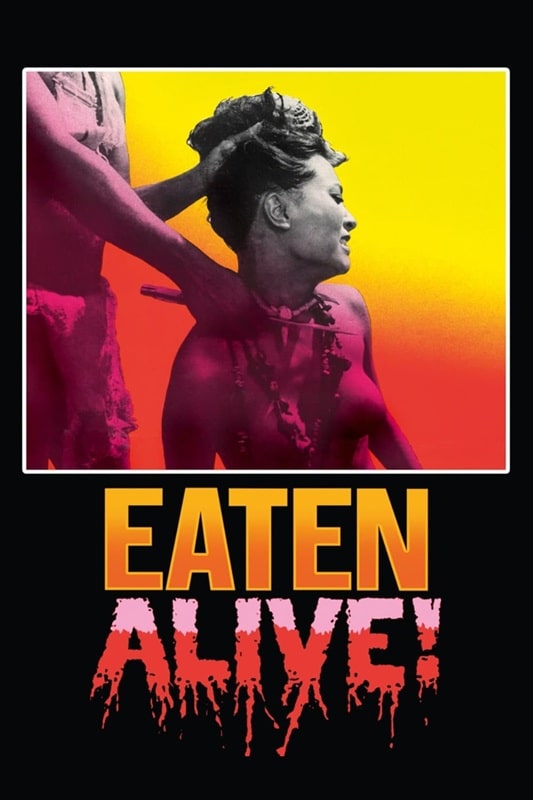
Primitives (Rapi Films, 1978) and Eaten Alive! (Dana Film, March 20, 1980)
This one is an Indonesian version of the Italian jungle exploitation flicks, and doesn’t just follow a similar plot, but lifts whole sequences directly for previous fare such as Cannibal Holocaust. In fact, it’s pretty shameless how much is ripped off from that movie, right down to locations and set pieces (although it stops short of actual tallywhacker removal). It’s full of the usual grunting and chomping, and the filmmakers seemed to double-down on the animal cruelty, using horrific footage from previous films.
It’s a miserable viewing experience, and I’m only giving it an extra mark for the shameless stealing of inappropriate music (Kraftwerk’s ‘The Robots, a trio of Jean Michel Jarre tracks and Princess Leia’s theme) and a hilarious rubber axe boomerang scene.
4/10
Eaten Alive! (1980) TubiNot to be confused with the Tobe Hooper ‘gator romp, this is another Italian cannibal flick that starts interestingly in New York, but then descends into the usual animal torture and misogyny associated with these films.
It’s held together by a flimsy ‘Jonestown’ plot, but this was the one that officially finished me off — I am totally done with this genre and never need to see another jungle cannibal film ever again. Hateful.
1/10
Previous Murkey Movie surveys from Neil Baker include:
There, Wolves
What a Croc
Prehistrionics
Jumping the Shark
Alien Overlords
Biggus Footus
I Like Big Bugs and I Cannot Lie
The Weird, Weird West
Warrior Women Watch-a-thon
Neil Baker’s last article for us was There, Wolves: Part III. Neil spends his days watching dodgy movies, most of them terrible, in the hope that you might be inspired to watch them too. He is often asked why he doesn’t watch ‘proper’ films, and he honestly doesn’t have a good answer. He is an author, illustrator, outdoor educator and owner of April Moon Books (AprilMoonBooks.com).
6 Books Begging To Be Held & The Advantages of Reading Them
In a society ruled by digital displays, it’s simple to overlook the pure pleasure and…
The post 6 Books Begging To Be Held & The Advantages of Reading Them appeared first on LitStack.
ROSE / HOUSE by Arkady Martine
Rules for Mega-Dungeon Adventuring: Dragonslayer by Greg Gillespie
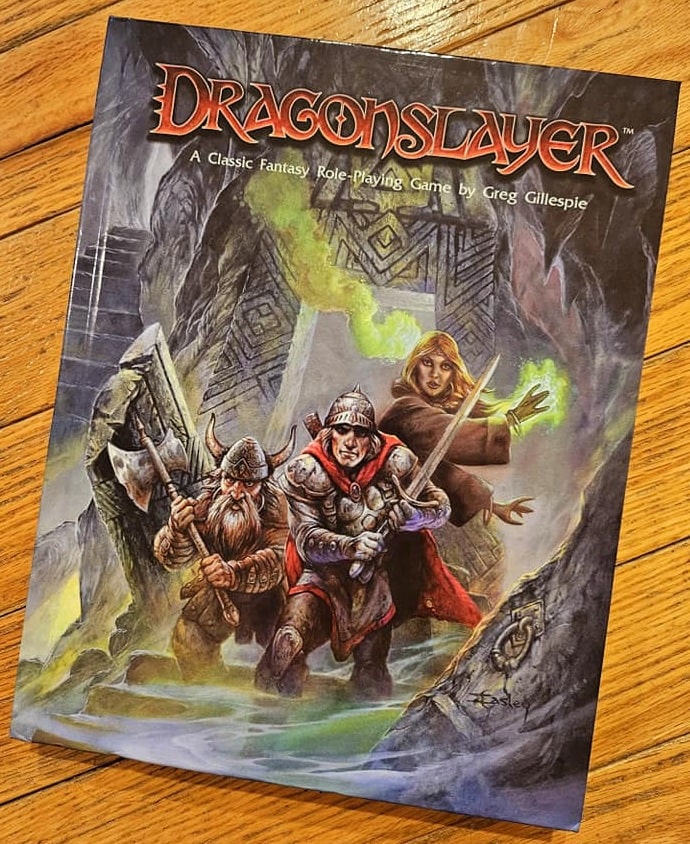
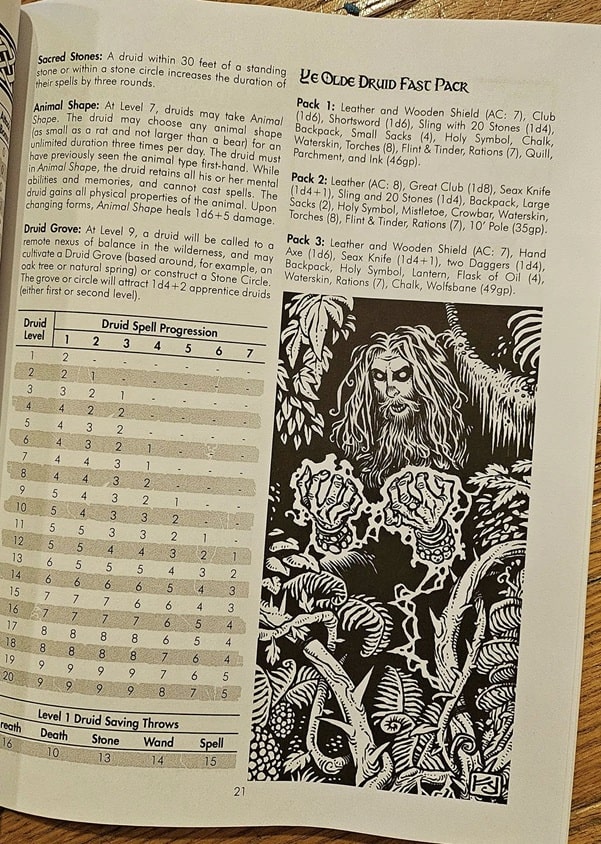
Dragonslayer (OSR Publishing, February 7, 2024). Cover by Jeff Easley
I’ve admired the mega-dungeon adventures of Greg Gillespie for several years, particularly Barrowmaze and The Forbidden Caverns of Archaia. Most recently, Greg published his own set of rules to go with those adventures. It’s called Dragonslayer, and I think it’s excellent. Here is the description from the back of the book:
Journey to a realm of myth and magic, where ancient legends and terrifying minsters come to life, and adventure awaits…
Inspired by the timeless role-playing tradition of the early 1980s, this ruleset seamlessly integrates the simplicity of B/X with the chrome if First Edition. The book has everything you need: classes, spells, monsters, and treasure, combined in a single volume.
For those who don’t know, “B/X” is the acronym for the Basic and Expert rules of Dungeons & Dragons.
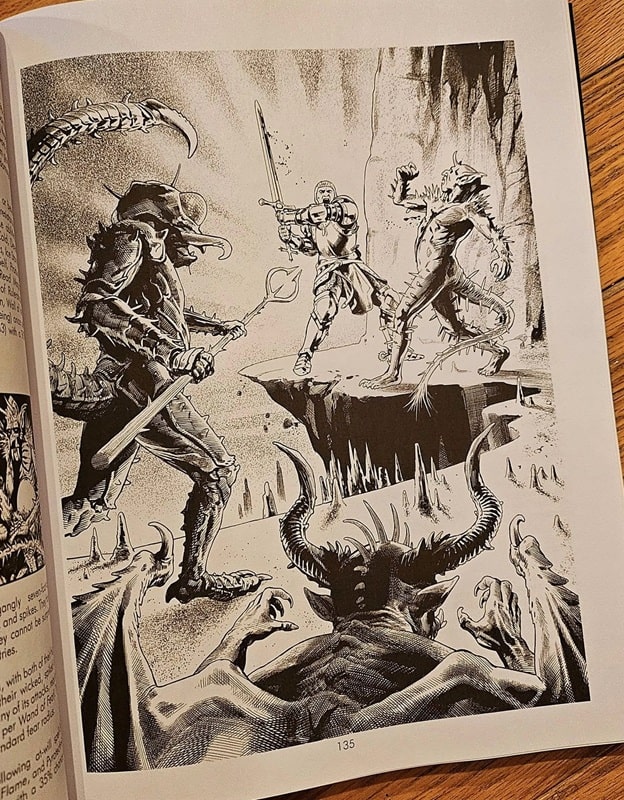
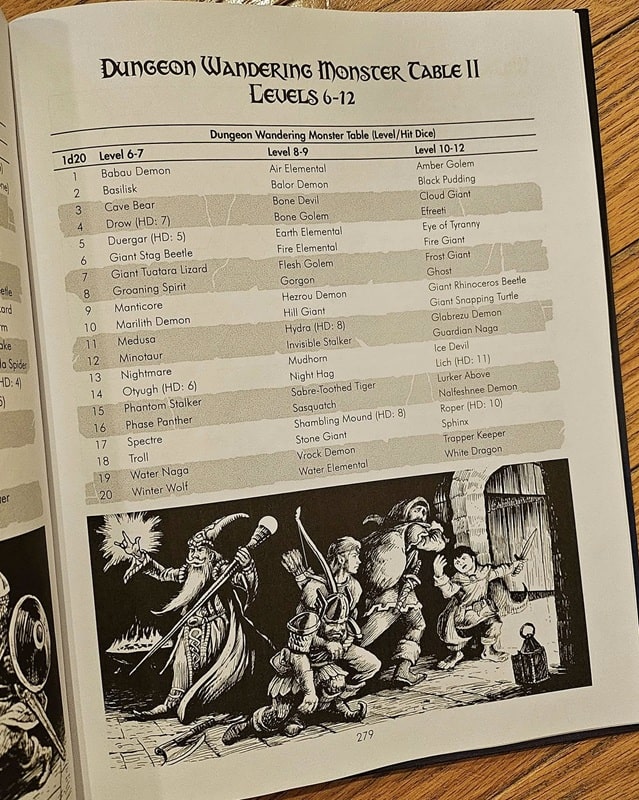
Interiors from Dragonslayer
The Basic and Expert rules were conceived by Tom Moldvay and Zeb Cook, who in turn derived their inspiration from the works of Gary Gygax and Dave Arneson — and also the previous Basic set (my personal favorite) compiled by John E. Holmes.
B/X is probably the most “cloned” version of D&D, yet Greg establishes his own flavor, quite admirably, within that framework. It’s nicely done!
Lastly, it’s really great to see art from the likes of Jeff Easley, Diesel LaForce, and Darlene Artist. All legends of the hobby whose work I have admired for decades.
Jeffrey P. Talanian’s last article for Black Gate was a review of Robert E. Howard’s “Worms of the Earth.” He is the creator and publisher of the Hyperborea sword-and-sorcery and weird science-fantasy RPG from North Wind Adventures. He was the co-author, with E. Gary Gygax, of the Castle Zagyg releases, including several Yggsburgh city supplements, Castle Zagyg: The East Mark Gazetteer, and Castle Zagyg: The Upper Works. Read Gabe Gybing’s interview with Jeffrey here, and follow his latest projects on Facebook and at www.hyperborea.tv.
What Moves the Dead - Book Review (reread/repost)

What Moves the Dead (Sworn Soldier #1)by T. Kingfisher
What is it about:From the award-winning author of The Twisted Ones comes a gripping and atmospheric retelling of Edgar Allan Poe's classic "The Fall of the House of Usher."
When Alex Easton, a retired soldier, receives word that their childhood friend Madeline Usher is dying, they race to the ancestral home of the Ushers in the remote countryside of Ruritania.
What they find there is a nightmare of fungal growths and possessed wildlife, surrounding a dark, pulsing lake. Madeline sleepwalks and speaks in strange voices at night, and her brother Roderick is consumed with a mysterious malady of the nerves.
Aided by a redoubtable British mycologist and a baffled American doctor, Alex must unravel the secret of the House of Usher before it consumes them all.
What did I think of it:I totally pre-ordered this book because it sounded cool and I couldn't resist that cover! (The end-papers have a really cool illustration as well.)
And this is indeed a really cool read!
It's a retelling of Edgar Allan Poe's "The Fall of the House of Usher." , but you can definitely read it without having read Poe's original. It's atmospheric, disturbing, and delightfully creepy.
I loved Alex, they're a great hero: down to earth, pragmatic, but also caring towards their friends. And their narration brings some humor to an otherwise creepy tale. Having read a lot of Poe's works, the plot wasn't unfamiliar, but the way Kingfisher gave it life and brought new things to it made that I was invested from the start.
A warning to those who might have read other books by Kingfisher (A Wizard’s Guide to Defensive Baking or Paladin's Grace for example): Kingfisher is a pen name used by Ursula Vernon for anything that doesn't fit the Ursula Vernon name, so this book is very different than some of the other books written under the Kingfisher name.
You bet i'll be trying to find more creepy, atmospheric beauty among the Kingfisher books though!
Why should you read it:It's a delightfully atmospheric read.
Thoughts on rereading:Yup: Still just as beautifully atmospheric as the first time. A total keeper. Now on to read the next one.






Recent comments